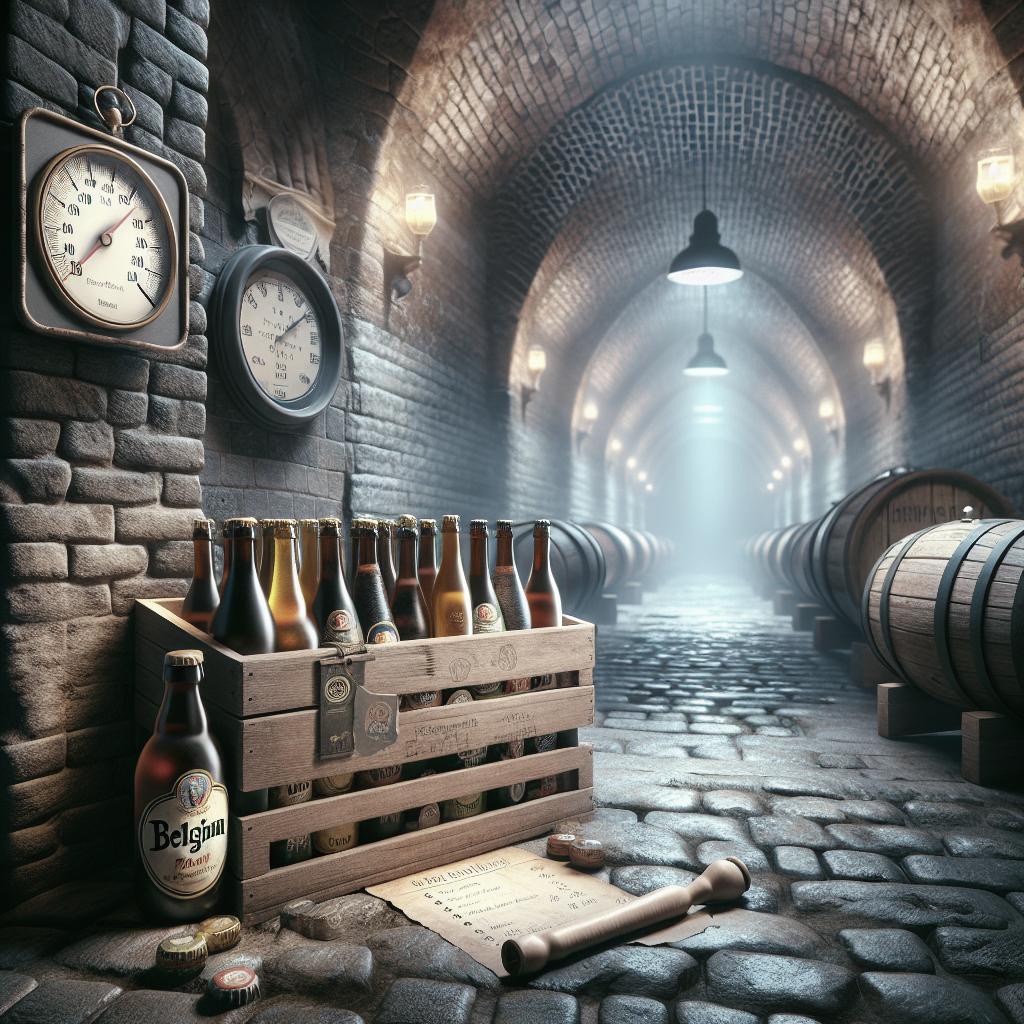“`html
How to Store Belgian Beer for Optimal Taste
Belgian beer is known for its rich flavors and unique brewing traditions. Proper storage is essential to preserving its optimal taste and characteristics. In this post, we explore best practices for storing Belgian beer, focusing on the importance of keeping beer unopened, positioning it upright, and understanding the impact of environmental factors like humidity, light exposure, and temperature variations. We also discuss how to minimize oxidation risks in different beer types. By the end of this guide, you’ll be equipped with the knowledge to ensure your Belgian beer maintains its intended quality and flavor for as long as possible.
Never Try to Store an Opened Beer
It’s paramount to understand that once a beer is opened, its shelf life diminishes significantly. Exposure to air can lead to oxidation, which transforms the beer’s flavor profile, often resulting in a stale or “off” taste. Therefore, if you crack open a bottle of Belgian beer, plan to enjoy it within a few hours.
Sealing an opened beer is nearly impossible without special equipment that limits air exposure. Even resealing with bottle caps or similar methods will likely not prevent air from affecting the beer. Therefore, it’s best to store Belgian beer unopened until you’re ready to savor it.
Always Store Beer Upright
Storing beer upright plays a critical role in preserving its quality. Unlike wine, beer benefits from minimal contact between the liquid and the closure, such as a bottle cap or cork. Upright storage helps minimize any potential interaction between beer and closure, thereby reducing risk of contamination.
Upright storage also assists in maintaining the integrity of the yeast sediment in unfiltered beers. For some Belgian ales, yeast residue at the bottom of the bottle contributes to flavor development and can enhance the beer’s character when it’s time for consumption.
The Effects of Humidity on Cellaring Beer
High humidity levels can wreak havoc on beer labels and packaging, but most importantly, they can impact the integrity of bottle caps or corks over time. Optimal humidity levels for beer storage hover around 60-75%. This range is conducive to maintaining closure quality without risking the proliferation of mold.
In cellaring conditions where Belgian beers are often aged, humidity plays a vital role. Any deviation beyond the optimal range can lead to premature aging or spoilage, which diminishes the beer’s carefully crafted flavors. Thus, ensuring stable humidity levels can support long-term storage success.
Light Strike & Bottle Types
Light exposure is a known adversary to beer quality, and Belgian beers are no exception. Beer packaged in clear or green bottles is particularly vulnerable to “light strike,” a phenomenon where sunlight or fluorescent light reacts with the hops, causing skunky flavors.
Opting for beer in brown bottles offers additional protection, as they provide barriers that reduce light penetration. For long-term storage, ensuring the beers are kept in dark, cool environments offers optimal conditions to prevent unwanted flavor changes.
Light Strike & Cans
Cans offer a noticeable advantage over bottles regarding light protection. Their opaque nature ensures no light can penetrate the packaging, safeguarding the beer from any light-induced flavor alterations.
Although cans usually signify quality assurance when it comes to light exposure, it’s still essential to maintain optimal temperature and humidity levels. This ensures the flavor integrity of your Belgian beer remains uncompromised over time.
Home Experiment: Create a Skunked Beer
To understand the effects of light strike firsthand, you can conduct a simple home experiment. Choose two identical Belgian beers, keeping one in its original packaging in a dark space and placing the other in direct sunlight for 24 hours.
After the exposure, open both beers and pour them into glasses. You’ll notice a distinct difference in aroma and taste between the two. This will underscore the necessity of proper light management for preserving beer quality.
Two Negative Effects of Heat
Heat is another environmental factor that adversely impacts Belgian beer storage. Firstly, high temperatures accelerate the aging process of beer. While aging can enhance certain robust brews, these changes are undesirable for lighter ales.
Secondly, heat can also lead to flavor degradation by encouraging the growth of bacteria or yeast beyond intended levels. To mitigate these risks, Belgian beer should be stored at consistent temperatures ideally between 45-60°F (7-15°C).
Temperature Rules of Thumb
Every Belgian beer style has its preferred storage temperature, but a few general rules of thumb can guide you. Lighter ales and lambics are best kept on the cooler end of the spectrum, while robust Belgian ales can afford slightly warmer storage conditions.
Keeping your Belgian beer in environments with fluctuating temperatures can lead to undeniable flavor inconsistencies. Therefore, investing in temperature-controlled fridges or cellars offers peace of mind for both short-term enjoyment and long-term cellaring.
Oxidation in Pale Beers
Pale beers, like many Belgian blonde ales, are especially vulnerable to oxidation due to their subtle profiles. When exposed to oxygen, their flavors can quickly taper into cardboard or paper-like notes, resulting in lackluster drinking experiences.
To minimize oxidation, it’s vital that these beers are stored in airtight conditions. Ensuring bottle caps are intact and that they’re stored upright can significantly delay oxidation processes, maintaining the intended refreshing character of pale Belgian beers.
Oxidation in Dark Beers
Dark Belgian beers, such as dubbels or quadrupels, generally hold up better to oxidation due to their deeper flavor profiles. The presence of malty, roasted, or caramel notes means that minor oxidation can sometimes metamorphose flavors in complementary ways.
Nonetheless, excessive oxidation can still deteriorate the distinct character of these beers over time. To preserve their flavor integrity, follow similar storage precautions as for pale beers, with a particular focus on maintaining airtight environments.
How to Minimise Oxidation
To minimize oxidation, maintaining a consistent storage environment is key. Use airtight containers or sealers where applicable, and prevent frequent temperature fluctuations that accelerate the oxidation process.
Further, consider investing in vacuum sealers for home storage. These devices remove air from around your beer, preserving its quality over extended periods. With these methods, the longevity and taste of your cherished Belgian beers remain intact.
Future Prospects
| Storage Tip | Key Point |
|---|---|
| Never Store Opened Beer | Consumes promptly to prevent oxidation. |
| Always Store Beer Upright | Minimizes contact with closure, preserving quality. |
| Effects of Humidity | Optimal humidity (60-75%) avoids spoilage. |
| Manage Light & Temperature | Store in dark, cool places to maintain quality. |
| Minimize Oxidation | Use airtight storage to prolong beer’s flavor life. |
“` This HTML document presents an informative guide on storing Belgian beer for optimal taste by adhering to strategic practices and environmental factors. The guide concludes with a summary table for a concise future reference.


